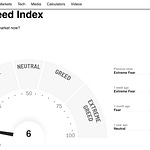To investors,
The conversation around the energy consumption of the bitcoin network continues to be front and center in the mainstream media. Last night I saw a tweet from Andrew Ross Sorkin of the NY Times and CNBC that reminded me how nuanced the details can be.
It all started with a screenshot of this chart from Galaxy Digital’s research team:


Andrew immediately jumped on the chart and said that the comparison was laughable. His main point is that the legacy banking system serves many more people, along with many more transactions, so of course it is going to consume more energy. Makes sense, right?


This is where the nuances come into play. The legacy financial system has a linear relationship between usage and energy consumption. The more users that participate in the system, the more energy it consumes. The more transactions that occur in the legacy system, the more energy it consumes.
This increase in energy consumption comes from more bank branches, more ATMs, more bank data centers, more end points in the card networks, and much more. Increase the users, increase the energy consumption. Increase the number of transactions, increase the energy consumption.
Thankfully, this is not how the bitcoin network works. There is no linear relationship between usage and energy consumption. The blockchain requires the same energy consumption to process blocks of transactions whether the blocks have 10 or 100 or 1,000 transactions in them. In the same vein, the network consumes the same energy regardless of whether 2 people are using it or 2 million people. This is what a non-linear relationship between usage and energy consumption looks like.

As if that wasn’t important enough, there are also numerous efforts underway across blockchains to leverage layer 2 technology for scaling. This would allow for more and more transactions to occur on the blockchain, but without stuffing the blocks with transactions (which causes higher fees and slower transaction times).
A perfect example of this is Stacks, which builds smart contracts for bitcoin. The founder jumped into the thread last night and explained:

In the most simplistic sense, there are thousands or millions of transactions that can happen on a layer 2 or a side-chain. Those high volume of transactions can then be settled in a single transaction entry on the bitcoin blockchain. This means that the addition of thousands or millions of transactions (and by proxy many more users) would have no impact to the energy consumption of the layer 1 bitcoin blockchain.
This brings us back to the point that Galaxy Digital was making in their research that was shared in the first tweet of this letter. The legacy banking system has to increase energy consumption as more people become banked, while also increasing energy consumption to service more transactions. Bitcoin, on the other hand, does not need to do this. It simply leverages scaling technology to increase user adoption and transaction velocity without having to materially increase energy consumption.
So where exactly does the increase in energy consumption come from?
The simple answer is the financial incentive for decentralization. Here is how it works — every block of transactions carries with it the “block reward.” This block reward started out as 50 bitcoin and has been cut by 50% every 4 years. Today the block reward is 6.25 bitcoin (about every 10 minutes). This means that miners in totality are paid approximately $36.2 million per day at the current price of bitcoin. If you want your share of the $36.2 million in daily revenue, you start bringing more mining equipment online.
The more miners that the join the network, the more decentralized the network becomes. This is a beautiful financial incentive to optimize for the one thing that bitcoin presents as the most important thing — decentralization.
It doesn’t matter how many users or how many transactions occur on the bitcoin network. The greatest input for determining energy consumption increase or decrease is the value of the block reward (or daily revenue for miners). I bring this up because it is important to understand that the comparison of the legacy banking system and the bitcoin network is a solid analysis. Bitcoin could run the entire financial system on the current energy consumption (in terms of users and transactions). That would occur via the scaling technologies on layer 2 / side-chains.
Obviously, the technology is not ready for that level of velocity, but ultimately that is where we are moving towards. That doesn’t meant that energy consumption won’t increase in the future. In fact, it is nearly guaranteed to increase over time. But the reason for the increase won’t be more users and transactions, but rather because the economic reward for improving the decentralization will only increase in value.
Understanding the nuances of this debate are important. It leads to a much clearer picture of why decentralization is so important, how that decentralization is achieved, and why bitcoin is inevitable over the coming decades.
Hope each of you has a great Wednesday. I’ll talk to everyone tomorrow.
-Pomp
Do you want to work in the Bitcoin and crypto industry? Do you run a business that has open roles to fill? I recently launched the industry-leading job board focused on our industry. We have hundreds of open roles at companies like Coinbase, Gemini, BlockFi, and many others.
Get a Job or Post a Job here: http://www.pompcryptojobs.com
THE RUNDOWN:
Michael Saylor: Mining Council Will ‘Defend’ Bitcoin Against ‘Uninformed’ and ‘Hostile’ Energy Critics: The Bitcoin Mining Council was born of a desire to help shape the narrative around the cryptocurrency’s energy use, said MicroStrategy CEO Michael Saylor. Speaking Tuesday at CoinDesk’s Consensus 2021, the bitcoin (BTC, +6.84%) evangelist said he worked with Tesla CEO Elon Musk and a handful of North American miners to create a loose organization that could publish energy usage data in an effort to address concerns that the cryptocurrency is not environmentally friendly. Read more.
Tom Brady to Speak at Consensus 2021: Football all-star and non-fungible token (NFT) entrepreneur Tom Brady has accepted a surprise invitation to speak at the closing night of Consensus 2021 with crypto tycoon Sam Bankman-Fried. Bankman-Fried, CEO of the popular crypto exchange FTX and liquidity provider Alameda, tweeted the invitation at Brady Wednesday morning – nodding to the Tampa Bay Buccaneers quarterback’s recent switch to a “laser eyes” profile picture. Read more.
Ex-High School Classmates Are Among the World’s Largest Crypto Holders: Kyle Davies and Su Zhu started Three Arrows Capital at the kitchen table of their apartment in 2012. Now they’re among the world’s biggest crypto holders with a portfolio worth billions of dollars.Read more.
Mark Cuban Invests in Ethereum Layer 2 Polygon: Billionaire investor Mark Cuban has made an investment in Polygon, a layer 2 Ethereum scaling solution. Cuban confirmed the investment in an email to CoinDesk but would not disclose its size or composition. The price of MATIC, the native token of Polygon, is up more than 9,535% year to date, according to Messari. Read more.
TechCrunch Founder’s Apartment to Be Sold as NFT: TechCrunch founder and crypto investor Michael Arrington is selling an apartment in Kiev via a non-fungible token. Arrington purchased the Ukraine apartment in 2017 through the real estate platform Propy, using Ethereum and smart contracts to settle the deal. In a sign of how the industry has evolved in the intervening four years, Propy will be auctioning the same property but this time as a real estate-backed NFT. The starting price is $20,000.Read more.
LISTEN TO THIS EPISODE OF THE POMP PODCAST HERE
Jessica Vaugn is a former Playboy Playmate who has reinvented herself as a talented photographer. She also has become a staunch proponent of bitcoin over the last few months.
In this conversation, Jessica and I discuss:
Fake news
Elon Musk
Miami
Federal Reserve
Laser Eyes
Relative Wealth
Optimism vs Realism
I really enjoyed this conversation with Jessica. Hopefully you enjoy it too.
LISTEN TO THIS EPISODE OF THE POMP PODCAST HERE
Podcast Sponsors
These companies make the podcast possible, so go check them out and thank them for their support!
Exodus is an absolute game changer in the crypto wallet space. With over 100 assets supported, one-click built-in exchange, Trezor hardware wallet integration and 24/7 customer support, this is a no brainer for both newcomers and crypto heavyweights. Download Exodus on desktop, iOS, and Android using my code http://get.exodus.com/pomp
Cosmos is building the Internet of Blockchains, marking a new era of interoperability, scalability, and usability. Dive into Cosmos at cosmos.network/pomp
OKEx is a leading crypto exchange known for providing the most options for crypto traders and investors. You can invest, trade, and earn yield, all within one place at okex.com. OKEx is not available to customers in the United States.
Choice is a new self-directed IRA product that allows you to buy Bitcoin with tax-advantaged dollars, while still holding your private keys. You can go to retirewithchoice.com/pomp to sign up today.
Unstoppable Domains makes crypto easier by replacing your address with [AnyName].crypto. Go to unstoppabledomains.com and get [YourName].crypto to make your crypto life easier.
BlockFi provides financial products for crypto investors. Products include high-yield interest accounts, USD loans, and no fee trading. To start earning today visit: http://www.blockfi.com/Pomp
Crypto.com allows you to buy, sell, store, earn, loan, and invest various cryptocurrencies in an user friendly mobile app.
Public Rec is where indoor comfort meets outdoor style. Comfort starts with a better fit. Free shipping. Free returns. Visit www.publicrec.com/pomp and use POMP at checkout to get 10% off.
Circle is a global financial technology firm that enables businesses of all sizes to harness the power of stablecoins and public blockchains for payments, commerce and financial applications worldwide. Learn more at circle.com.
Gemini is a leading regulated cryptocurrency exchange, wallet, and custodian that makes it simple and secure to buy bitcoin, ether, and over 30 other cryptocurrencies. Open a free account in under 3 minutes at gemini.com/pomp and get $20 of bitcoin after you trade $100 or more within 30 days.
Revolut is a finance app in the US and UK, that say they're the simplest way to access crypto. Sign up today at Revolut.com/pomp and make 3 card transactions to get $15, which you can exchange for any tokens Revolut supports.
NEAR’s fast, scalable, low-cost, open-source platform. Learn why NEAR is the infrastructure for innovation at near.org
Kraken makes it easy to buy and sell 60+ cryptocurrencies. Visit Kraken.com/pomp to get started today.
You are receiving The Pomp Letter because you either signed up or you attended one of the events that I spoke at. Feel free to unsubscribe if you aren’t finding this valuable.
Nothing in this email is intended to serve as financial advice. Do your own research.











